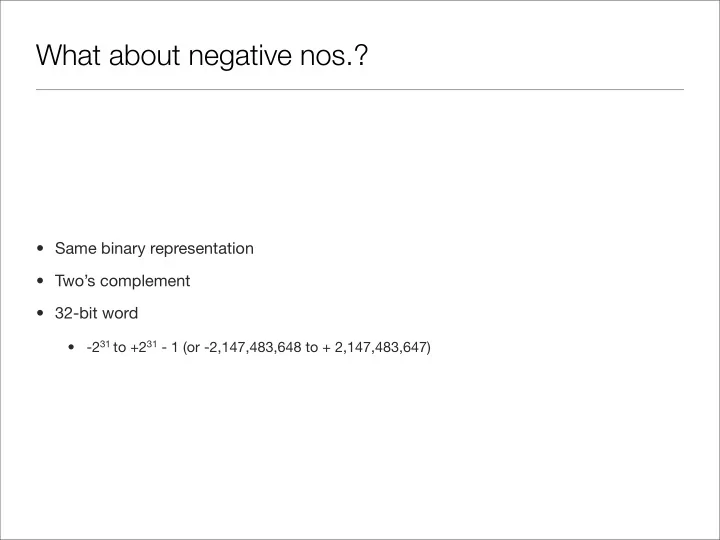

What about negative nos.? • Same binary representation • Two’s complement • 32-bit word • -2 31 to +2 31 - 1 (or -2,147,483,648 to + 2,147,483,647)
Control Decision making instructions • alter the control flow, – i.e., change the "next" instruction to be executed – MIPS conditional branch instructions: • � bne $t0, $t1, Label � beq $t0, $t1, Label Example: � if (i==j) h = i + j; • � � bne $s0, $s1, Label � � add $s3, $s0, $s1 � Label: � .... 22
Control MIPS unconditional branch instructions: • j label Example: • � if (i!=j) � � beq $s4, $s5, Lab1 � h=i+j; � � add $s3, $s4, $s5 � else � � � j Lab2 � h=i-j; � � Lab1: � sub $s3, $s4, $s5 � � � � Lab2: � ... while (i != j) Can you build a simple for loop? • i +=1 23
So far: • Instruction � � Meaning add $s1,$s2,$s3 � $s1 = $s2 + $s3 sub $s1,$s2,$s3 � $s1 = $s2 – $s3 lw $s1,100($s2) � $s1 = Memory[$s2+100] sw $s1,100($s2) � Memory[$s2+100] = $s1 bne $s4,$s5,L � Jump to L if $s4 � $s5 beq $s4,$s5,L � Jump to L if $s4 = $s5 j L �� Next instr. is at L • Formats: op rs rt rd shamt funct R I op rs rt 16 bit address J op 26 bit address
Control Flow We have: beq , bne • what about Branch-if-less-than ? • • New instruction: � � � � � if $s1 < $s2 then � $t0 = 1 slt $t0, $s1, $s2 else $t0 = 0 Similarly, the constant version: slti $t0, $s1, 10 • Also, can compare with register $z0 • How to implement blt (branch–if–less–than)? •
Assembly Language vs. Machine Language Assembly provides convenient symbolic representation • much easier than writing down numbers – e.g., destination first – Machine language is the underlying reality • e.g., destination is no longer first – Assembly can provide 'pseudoinstructions' • • e.g., “ move $t0, $t1 ” exists only in Assembly • would be implemented using “ add $t0,$t1,$zero ” When considering performance you should count real instructions • � 26
Supporting Functions (procedures)
What is needed? • Functions: Analogy of a spy • secret plan, acquire resources, perform task, cover tracks, return with result • Program has to • place params for function’s access • transfer control to procedure • acquire storage resources for the function • perform function’s instructions • place result for calling program’s access • return control to point of origin
Using registers • Registers are fast! $a0 – $a3 : argument registers • $v0-$v1 : value registers • $ra : return address register •
Jump-Link and Program Counter • Jump-and-link instruction jumps to addr, store next instruction’s addr in $ra : the return address • • jal ProcedureAddress • Program Counter ( PC ) • address of current instruction • � , jal stores PC + 4 to setup procedure return • � , another instruction: jr $ra • jumps to address in $ra
Setup for Executing Functions • Caller puts params in $a0 – $a3 • Uses jal X to jump to callee procedure X • Callee performs its instructions • Places results in $v0 – $v1 • Returns to caller by $jr $ra
Recommend
More recommend